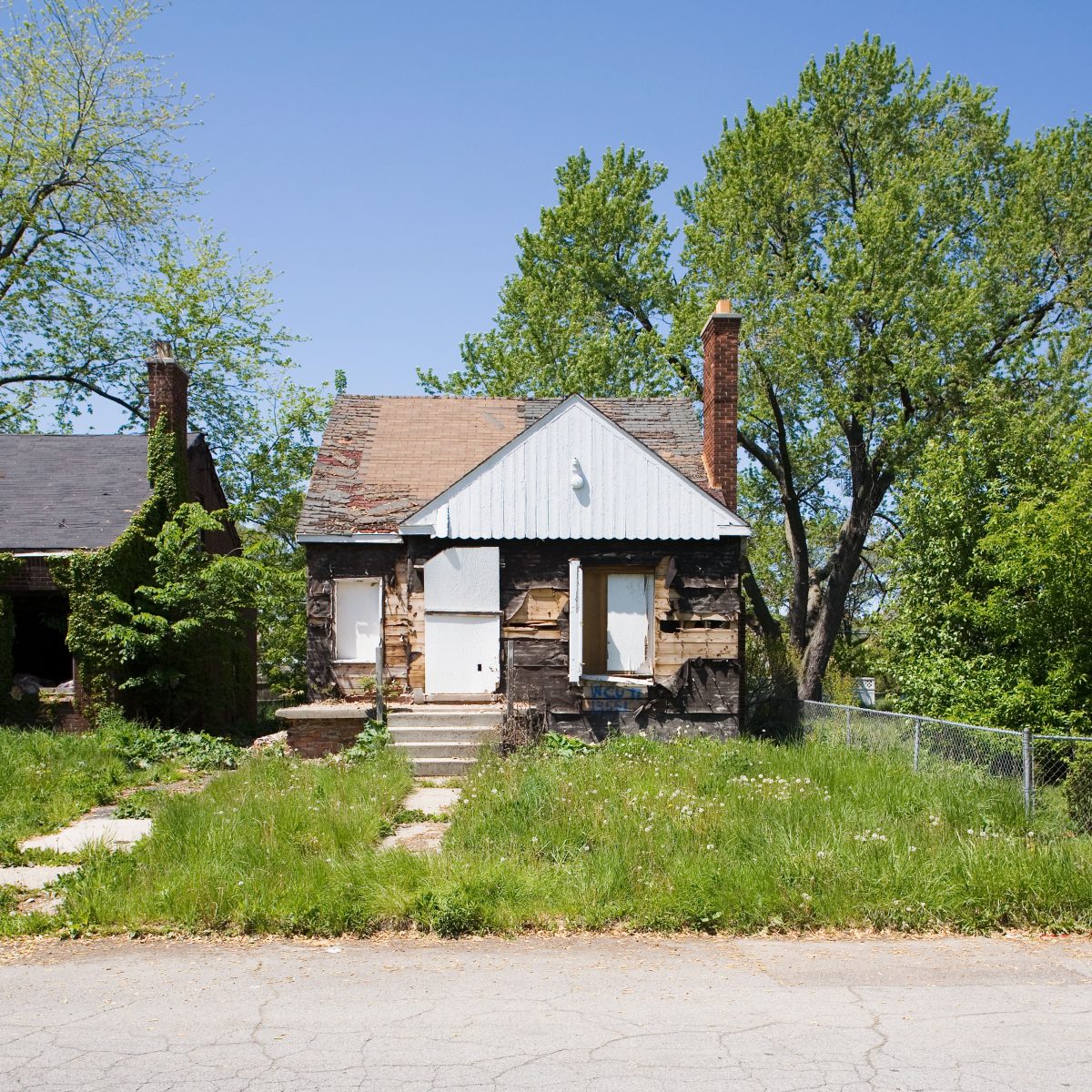After living and working for the past two years in D.C., and Denver, Colorado, coming back to the Detroit area is a real eye opener. What was once a maddening and frustrating place to live is now just plain depressing. With the real unemployment rate estimated to be near 20% for the state, and a ridiculously high 50% for the city of Detroit, still falling real estate values (down 40% in my area, and including our house), a crumbling infrastructure, financially strapped municipalities and school districts, and a apparent 50% commercial vacancy rate (just judging by what I can see..), the metro area seems to continually worsen. Each time I come back it seems that things couldn’t get worse (even though I don’t believe the area’s hit bottom yet), yet it always does.
Living in the area, one becomes accustomed to things residents in most other areas would never imagine. Roads that get complaints in other areas, metro Detroiters can only dream about. The public transit that others complain about being crowded or expensive, doesn’t even exist here. Same with the practically non-existent bike lanes. In Denver I ride my bike everywhere, only getting in the car to make longer distance trips. It’s something that I found to be unacceptably difficult here in southeastern Michigan. When I did make a trip by bicycle here, I was that strange person riding their bike on the road carrying grocery bags; presumably some poor sap who’d had his license taken away, or who didn’t have enough money for a car. In Denver, I’m just one of many using a bicycle for, believe it or not, transportation. Imagine that… Our neighbor here in metro Detroit would drive one block to buy cigarettes.
Driving around metro Detroit, it’s rare to see more than one or two people out getting exercise of any kind. In Denver it would be rare to see less than a dozen people exercising on my two mile ride to work. The weekly Wednesday night cruiser ride in Denver attracted up to 850 riders on a single night this past summer. Of course one has considering how many other options there are for socializing, entertainment, and outdoor activities. On any given week there will be rides, runs, creative Meetups, art openings, and just about anything else an active person under the age of 95 might enjoy. I know some of these things exist in metro Detroit, but the often long distance between them isn’t just inconvenient, but a huge waste of time, and dangerous when you consider all of the different highways one would have to travel to get from, say, Royal Oak to Ann Arbor on a weekday evening.
I have a point, beyond yet one more rant about the area. And the point is this: does anyone, who hasn’t left, or doesn’t want to leave, understand what needs to change about the metro area? Everyone knows that Michigan needs jobs. But I get the feeling that many who remain believe that those who left were weak, or quitters, or don’t like hard work. Those “quitters” who left the state, left because they had other opportunities…better opportunities, and most likely a chance at a better lifestyle. They didn’t leave because they weren’t up for a challenge. If an area offers jobs, and “opportunities” rooted in the past, and another area is embracing the future, why would I choose that challenge? If you can be on a better team, who wouldn’t choose it? Sure, some would rather be a big fish in a small pond, but this particular pond keeps getting smaller, and dirtier.
The point is often made that the area needs to bring back manufacturing jobs. I wouldn’t argue that manufacturing jobs…heck any jobs, would be good for the area. But maybe what the area really needs is to face reality. Metro Detroiters need to adapt to changing times. An education may be a good place for many to start. The claim is often made that metro Detroiters are scrappy, gritty, and hard working survivors. What mid-west city doesn’t believe that? The question is, what do survivors do when there old way of doing things doesn’t work anymore? They change their way of doing things. What did metro Detroit do when it was obvious the ways of the past were going to end soon? Nothing. Detroit made pretty much all of the same mistakes Pittsburgh has made, but unfortunately, unlike Pittsburgh, Detroit’s had very little of the fortuitous investments in other industries.
The question that should be asked, that often isn’t, is why have our young and highly educated citizens been leaving for decades? If the question was asked of every one of them, that has left the state, one would get a variety of answers from jobs to lifestyle. If you were to ask what it would take to get them to come back to metro Detroit, the answers would be equally varied, but I doubt many want to come back for traditional manufacturing jobs. Nor did many of them leave because of a lack of traditional manufacturing jobs. As a friend said the other night, “the state is a storefront. Why would anyone want to come in?”
When time Magazine offered advertising space for a campaign designed to draw this very demographic to southeastern Michigan, they asked five large agencies to answer the question, “If I’m young, talented and creative, and open to all kinds of opportunities, why Detroit?” Take a look at the ads… My personal opinion is that these ads do a better job of answering, “if I’m young, talented and creative, and open to all kinds of opportunities, why leave Detroit?” The ads do a great job of pointing out the disconnect that exists between those who have lived here a long time, and made lots of money here, and those of a younger more mobile generation. Outside of the suburbs of Detroit, who cares about Kid Rock? It really makes me wonder, if these people even understand what types of music the target demographic listens to? I can tell you, it’s not Kid Rock. Not a single one touched on any compelling reason for someone from outside of the area, to relocated here. Why are we even asking the old guard how to attract a new generation of creative, enthusiastic, and highly motivated entrepreneurs and creatives? L. Brooks Patterson still wants to stake metro Detroit’s future on the widening of I-75 from 8 Mile to M-59. MDOT and SEMCOG still seem to believe all transportation should be done in an automobile. No bikes, no trains, no walking…again that’s for the Third World poor, such as those in New York, Chicago, Atlanta, San Francisco, Portland, Denver, London, Brussels, and Toronto.
The morning after I arrived back in metro Detroit, we watched part of a round-table discussion on a local news show. The topic was, of course, about the area’s future. It appeared that not one of the participants was under the age of 60. Not that those over 60 have nothing to contribute. But asking only those who lived through a very different time period how we should proceed into the future misses the point entirely. We are in this situation because we (they) thought that what worked in the past would surely work in the future. If it was good enough then, it’s good enough now. Needless to say, watching did not make me feel very encouraged about the future of metro Detroit. Does anybody here, in any leadership position, with any power, or with money, get it yet? Do they understand the real issues? Do they know what it’s going to take to bring people back, or to make them stay?





Comments
Thanks for your post and challenge. It is clear that any discussion of Detroit has a tremendous amount of anxiety, frustration, and anger just beneath the surface.
This city has continuously placed politics above place and people in a generations-long self-destructive movement. It is certainly time for a bold and courageous vision, and a recognition that the role of leadership is not to shrink our institutions and infrastructure to fit our depopulation, but instead to recognize that their real responsibility of leadership is to repopulate the city to fit the scale of its infrastructure and build the institutions to make it sustainable.
While I do not agree with all of their recommendations, I did like this phrase from the authors of “A Plan for Detroit” published recently in The New Republic – “Detroit will have to become a different kind of city, one that challenges our idea of what a city is supposed to look like, and what happens within its boundaries.”
I expect this is your point. Whether defined by gray hairs or Gen Y, it is time to envision a different kind of city.
It seems to me that the one thing that might be making young(er) people stay is moving back to pre-suburbs times, to pre-whiteflight situation. Once people can walk downtown Detroit and have shops, doctors, restaurants, gyms, theatres, schools and playgrounds at a walking (cycling :)) distance, they will want to stay. Hopefully.
Jim, I agree with much of your assessment of the area. I do think, however, that the city may have to shrink the areas that it services in order to contain costs. The city of Denver has almost as much area, and less people than Detroit. So the argument that Detroit is too big, rings a bit hollow. I think the difference is how the areas are utilized in each city. A large portion of Denver is the airport, and the surrounding, often empty land.
In Detroit the empty land is spread out in a haphazard fashion that makes many services too expensive to maintain.
I am in complete agreement with the amount of frustration, lack of true leadership, and a dysfunctional political scene (hopefully it’s changing). And the city will be different, no doubt…it has to be, there is no other choice. A new vision is indeed needed.
Petr, there’s no doubt that the very people Detroit needs are moving to places like Chicago, Seattle, D.C., etc, for the very reasons you mention. Unfortunately, it’s hard to have those great amenities with a declining population. I guess the the big challenge is how to both, bring the people in, and build the amenities and infrastructure almost simultaneously. It may not be possible, so Detroit, and the region will have to figure out new ways to attract the people it needs.
Note that the city of Detroit is making decent progress towards adding bike lanes starting this construction season.
http://en.wikipedia.org/wiki/Cycling_in_Detroit
That’s great to hear Todd. Thanks!